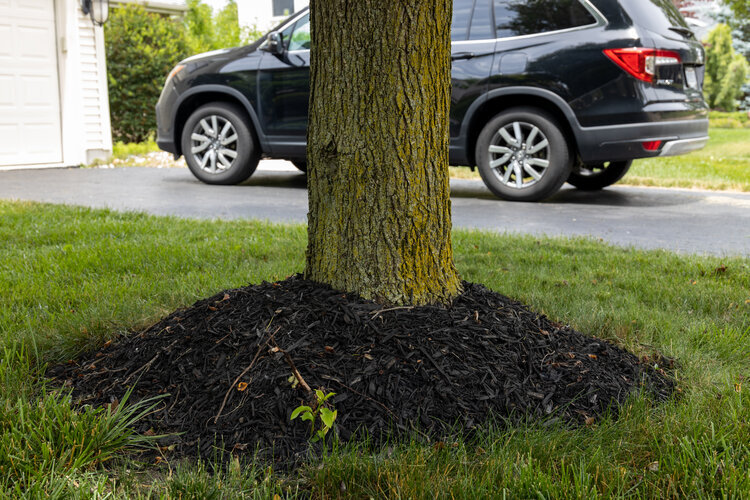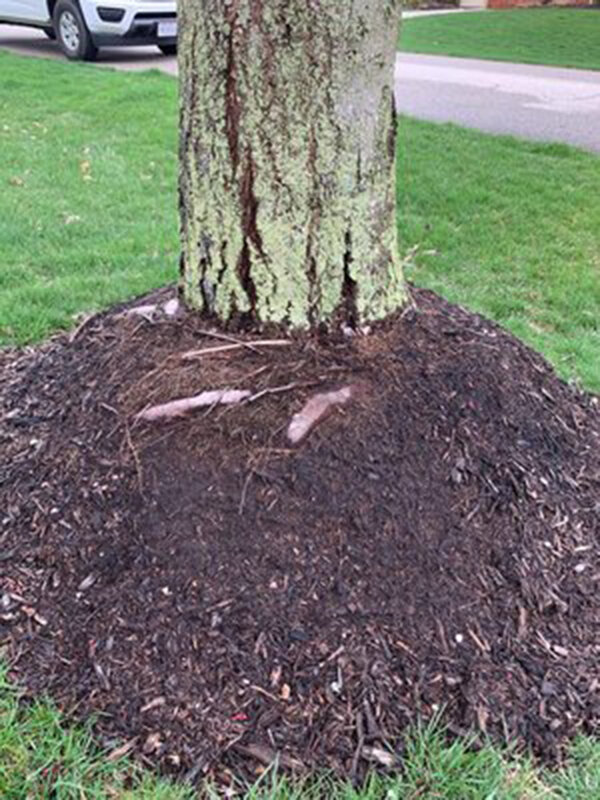By Enrique Arayata
ISA Certified Arborist® OH-7252A
April 7, 2021
Mulching is an important aspect of tree maintenance that is both functional and decorative, adding to your tree’s lifespan and helping it look its best. The main benefits of tree mulching are that it deters weeds, improves soil quality, protects trees from lawnmower damage, insulates soil from extreme temperatures, and retains moisture during hot weather. Today, I would like to talk about some tips and tricks on how to properly mulch a tree. At the top of this article is an instructional video hosted by ISA Certified Arborist Lindsey Rice that can be used to follow along while mulching your own tree!
Example of a properly mulched tree
To mulch a tree, you will need organic wood chip mulch, a shovel, a rake, and personal protective equipment such as safety glasses, gloves, and boots. A wheelbarrow or air spade may potentially be needed depending on the situation. The best time to mulch a tree is in the fall or spring. Many trees are incorrectly mulched when the mulch is too high or when it covers the root collar of the tree, which is where the trunk and roots meet. The mulch only needs to be 1 to 2 inches deep and the root collar should be completely exposed in order to properly receive oxygen. This will help prevent girdling roots, which are roots that wrap around the trunk in search of oxygen. This can suffocate a tree and add unnecessary stress. If your tree has girdling roots or a mulch volcano, you will need to resolve these issues prior to mulching.
If there are no girdling roots, the first step is to pull out any weeds surrounding the base of the tree. Then, you may begin applying mulch in a wide and evenly spread area. For younger trees, it is ideal to mulch all the way out to the canopy drip line, which is where the majority of a tree’s roots extend, but you may have to compromise depending on your landscape.
Example of a canopy drip line
For older trees, this is not as important. You should still see similar results when bringing the mulch out about 3 to 5 feet from the base. You can use a rake, shovel, or your hands to evenly distribute the mulch. The mulch only has to be about 1 to 2 inches deep at most, so make sure you avoid mounding, Leave about 2 to 3 inches of space between the mulch and the root collar in order for the tree to properly receive oxygen and to prevent girdling roots. This will also help prevent any moisture issues, which can lead to disease and rotting. Afterwards, you are all set!
For maintenance, water your mulch whenever it looks dry. Ohio can have inconsistent weather, so there is no need to water it on a scheduled basis. Also, only add mulch whenever it is looking sparse and below that 1 to 2 inch needed depth. Make sure you break up, turn over, and mix in the old mulch to prolong the mulch’s lifespan, prevent any clumping, and to allow maximum movement of oxygen and water. If there are any questions, please feel free to leave them in the comments section below and be sure to watch ISA Certified Arborist Lindsey Rice’s video for a visual guide on this topic! Good luck on your next mulching project!
Additional Reads!
Below are two excellent articles written by our ISA Certified Arborists related to mulch volcanoes and girdling roots.
”Mulch Mounds! Oh My!”
by ISA Board Certified Master Arborist José Fernández
“Are Your Trees Being Suffocated By Their Own Roots?”
by ISA Certified Arborist Chris Gill
Enrique Arayata I Media Production Manager, Russell Tree Experts
Enrique is an ISA Certified Arborist® and FAA Certified Remote Pilot. In his free time, he enjoys working out, hanging out with his family and girlfriend, video production, photography, cars, technology, and cooking. Enrique has a BA in moving image production with a double minor in film studies and studio art specializing in photography from The Ohio State University, and an AA in web graphic design from DeVry University. His favorite tree is the Kwanzan cherry tree.





